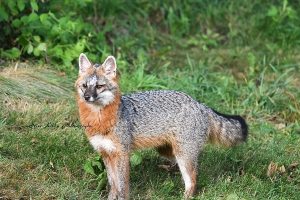Iowa DNR needs your help learn more about Iowa’s secretive Gray Foxes
December 14th, 2021 by Ric Hanson
(Des Moines, Iowa) – The Iowa DNR is asking for your help in learning more about the secretive Gray Fox species.
Gray fox were listed as a Species of Greatest Conservation Need in Iowa in 2015 based on a decline in the gray fox population observed over the past 25 years. Similar trends have been noted in several other Midwestern states. The gray fox is smaller than coyotes and red foxes. Adult gray foxes typically weigh 10 – 12 lbs. They are mostly gray with patches of reddish, tan fur down the side of their neck and body. A distinct black line extends down the top of their tail. Their face also has distinct black and white markings.
The gray fox population decline in Iowa is correlated with increases in the population of coyotes, raccoons, and bobcats. Increasing coyote and bobcat populations may affect gray fox populations through competition and predation. Raccoons may impact gray fox populations through the spread of disease, particularly canine distemper virus.

Small Gray Fox
Canine distemper is common in raccoons, and gray fox are highly susceptible to this lethal disease. Changes in our forests habitat may also contribute to lower gray fox numbers. Mature, even-aged forests don’t support the prey base needed for gray fox. However, the cause or causes of the decrease in the Iowa gray fox population is unknown. A combination of these factors, as well as potential other unknown factors, may have contributed to their decline.
The Iowa Dept. of Natural Resources wildlife staff monitors the gray fox population in Iowa through surveys and harvest annually. For example, the Iowa Bowhunter Observation Survey began in 2004, and currently provides annual data upon which to base population trend analysis. Bowhunters record the amount of time they spend in the field, and the number of gray fox (along with other species of wildlife) they see during each hunt outing.
The bowhunter observation survey allows us to standardize the number of sightings based on the amount of time or effort spent bowhunting, resulting in an index that provides insight into trends in furbearer populations such as gray fox. The Iowa Dept. of Natural Resources wildlife research staff are initiating efforts to conduct a pilot study to monitor and gather information on gray foxes, so we can begin the process of understanding the causes of their population decline. Due to their already low numbers, you can help out the DNR by providing them with gray fox locations!
The DNR is asking for information on any sightings or recent trail cam images (within the last 6 Months) of gray foxes that are alive. Just send an email or call Dave Hoffman or Vince Evelsizer with location information such as GPS coordinates or Twp,Rge,Sec. Dropping and sending a pin works great too.
Dave Hoffman – Iowa DNR Wildlife Phone: 641-425-0737; Email: david.hoffman@dnr.iowa.gov
Vince Evelsizer – Iowa DNR Wildlife Phone: 641-231-1522 Email: vince.evelsizer@dnr.iowa.gov
If you find a dead gray fox (roadkill, trapped, hunted, other) that’s in decent condition, we’d be interested in having the carcass for further examination/necropsy. Please contact Rachel Ruden (Iowa DNR Vet) or Vince Evelsizer if you do have one. Rachel Ruden – Iowa DNR Wildlife Veterinarian Phone: 515-823-8544; Email: Rachel.ruden@dnr.iowa.gov





